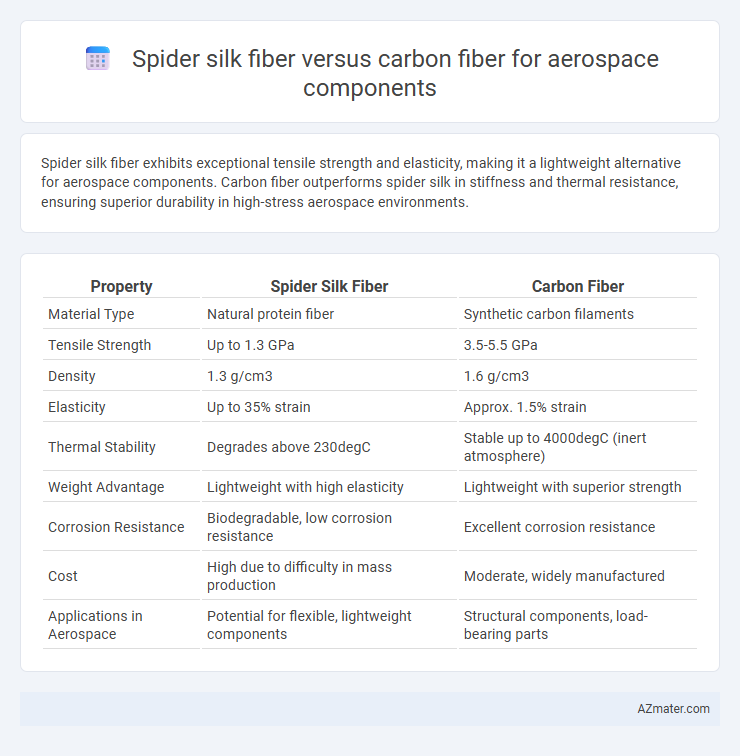Spider silk fiber exhibits exceptional tensile strength and elasticity, making it a lightweight alternative for aerospace components. Carbon fiber outperforms spider silk in stiffness and thermal resistance, ensuring superior durability in high-stress aerospace environments.
Table of Comparison
| Property | Spider Silk Fiber | Carbon Fiber |
|---|---|---|
| Material Type | Natural protein fiber | Synthetic carbon filaments |
| Tensile Strength | Up to 1.3 GPa | 3.5-5.5 GPa |
| Density | 1.3 g/cm3 | 1.6 g/cm3 |
| Elasticity | Up to 35% strain | Approx. 1.5% strain |
| Thermal Stability | Degrades above 230degC | Stable up to 4000degC (inert atmosphere) |
| Weight Advantage | Lightweight with high elasticity | Lightweight with superior strength |
| Corrosion Resistance | Biodegradable, low corrosion resistance | Excellent corrosion resistance |
| Cost | High due to difficulty in mass production | Moderate, widely manufactured |
| Applications in Aerospace | Potential for flexible, lightweight components | Structural components, load-bearing parts |
Introduction to Aerospace-Grade Fibers
Spider silk fiber and carbon fiber represent two advanced materials with distinct properties suitable for aerospace components. Spider silk fiber exhibits exceptional tensile strength, elasticity, and lightweight characteristics, making it a promising biomimetic material for flexible and impact-resistant aerospace applications. Carbon fiber, extensively used in aerospace, offers superior stiffness, high strength-to-weight ratio, and excellent thermal stability, crucial for structural integrity and high-performance conditions in aerospace engineering.
Overview of Spider Silk Fiber
Spider silk fiber exhibits exceptional tensile strength and elasticity, making it a promising biodegradable material for aerospace components. Its lightweight nature combined with high toughness and resistance to dynamic stress underscores its potential to enhance structural performance while reducing overall mass. Advances in synthetic production methods are addressing scalability challenges, positioning spider silk as a sustainable alternative to traditional composites like carbon fiber.
Properties of Carbon Fiber
Carbon fiber exhibits exceptional tensile strength, low density, and high stiffness, making it the preferred material for aerospace components requiring lightweight durability and resistance to fatigue. Its thermal stability and corrosion resistance further enhance performance in extreme aerospace environments, outperforming natural fibers like spider silk. The ability to tailor carbon fiber composites for specific mechanical properties allows engineers to optimize structural efficiency and safety in aircraft design.
Strength-to-Weight Ratio Comparison
Spider silk fiber exhibits an exceptional strength-to-weight ratio, surpassing many traditional materials, with tensile strength comparable to carbon fiber but significantly lower density. Carbon fiber, widely used in aerospace components, offers high stiffness and strength, enabling lightweight structural parts but with higher density than spider silk. The superior strength-to-weight ratio of spider silk fiber presents potential for future aerospace applications where minimizing mass without compromising tensile performance is critical.
Flexibility and Toughness
Spider silk fiber exhibits exceptional flexibility and toughness, enabling it to absorb significant impact energy without fracturing, which makes it highly adaptable for dynamic aerospace components. Carbon fiber, while extremely strong and stiff, has limited flexibility and can behave brittle under high stress, posing challenges in applications requiring deformation without damage. The inherent elasticity of spider silk fiber offers superior toughness compared to the rigid nature of carbon fiber, making it a promising material for aerospace parts subjected to complex mechanical loads.
Thermal Stability and Environmental Resistance
Spider silk fiber demonstrates exceptional environmental resistance, exhibiting high resilience to humidity and biodegradation, but its thermal stability remains limited with degradation occurring around 220degC. Carbon fiber, widely used in aerospace components, offers superior thermal stability, maintaining structural integrity at temperatures exceeding 600degC and providing excellent resistance to thermal oxidation. This makes carbon fiber more suitable for high-temperature aerospace applications, while spider silk fiber's eco-friendly properties favor less thermally demanding environments.
Manufacturing Scalability and Cost
Spider silk fiber offers exceptional tensile strength and flexibility but faces significant challenges in manufacturing scalability due to the complexity of biomimetic production processes and limited yield. Carbon fiber benefits from well-established industrial-scale manufacturing techniques, enabling mass production with consistent quality and lower per-unit costs despite its higher raw material expenses. Cost analysis reveals that carbon fiber remains the more economically viable option for aerospace components, given current scalability constraints and production inefficiencies associated with spider silk fiber.
Applications in Aerospace Engineering
Spider silk fiber exhibits exceptional tensile strength, elasticity, and lightweight properties, making it a promising biocompatible material for aerospace components requiring impact resistance and flexibility. Carbon fiber dominates aerospace engineering due to its high stiffness, low density, and excellent fatigue resistance, ideal for structural components, airframes, and turbine blades. Emerging research explores hybrid composites combining spider silk with carbon fiber to enhance damage tolerance and reduce weight in next-generation aerospace materials.
Future Potential and Research Directions
Spider silk fiber offers exceptional tensile strength, biodegradability, and flexibility, making it a promising material for lightweight aerospace components as research advances in synthetic production and scalability. Carbon fiber remains dominant due to its high stiffness, thermal resistance, and established manufacturing processes, but ongoing innovations aim to enhance recyclability and reduce environmental impact. Future research is focused on hybrid composites combining spider silk and carbon fiber to leverage strength-to-weight ratios while improving durability and sustainability in aerospace applications.
Conclusion: Choosing the Optimal Fiber for Aerospace Components
Spider silk fiber offers exceptional tensile strength, flexibility, and lightweight properties beneficial for aerospace components requiring high resilience and impact resistance. Carbon fiber provides superior stiffness, compressive strength, and thermal stability essential for structural parts subjected to extreme mechanical stresses and temperature variations. Selecting the optimal fiber depends on balancing the operational demands; carbon fiber excels in load-bearing frameworks, while spider silk fiber presents innovative potential for components needing flexibility and enhanced damage tolerance.

Infographic: Spider silk fiber vs Carbon fiber for Aerospace component
 azmater.com
azmater.com